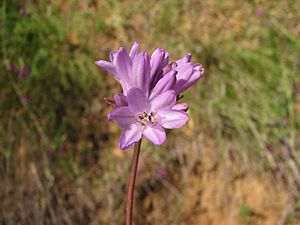Ookow facts for kids
Quick facts for kids Ookow |
|
|---|---|
 |
|
| Scientific classification | |
| Synonyms | |
|
Brodiaea congestum |
The ookow (pronounced OO-kow), also known as the fork-toothed ookow, is a beautiful wild plant. Its scientific name is Dichelostemma congestum. This plant is a type of flowering plant that comes back year after year.
Contents
Discover the Ookow Plant!
The ookow plant is a fascinating wildflower. It is known for its bright purple flowers that grow in a tight cluster. This plant adds a splash of color to the landscapes where it grows.
What Does the Ookow Look Like?
The ookow plant has a tall, thin stem that doesn't have any leaves. This stem can grow quite tall, making the flowers stand out. At the very top of the stem, you'll find a cluster of flowers. This cluster is called an inflorescence.
Each flower is about one centimeter wide and one centimeter long. They usually have six petal-like parts. These parts are a vibrant shade of bright purple. There can be anywhere from six to fifteen flowers packed together in one cluster.
Where Does the Ookow Grow?
This amazing wildflower is native to western North America. It grows in the hills and mountains of this region. You can find it from British Columbia in Canada, all the way south through the state of California in the United States. It also grows in Oregon and Washington (state).
It thrives in areas like the Sierra Nevada (United States) mountains and the California Coast Ranges. These places provide the perfect environment for the ookow to grow and bloom.
A Bit of History
Scientists have been studying the ookow plant for a long time. The first time this plant was officially described and named was in 1811. Back then, it was given the name Brodiaea congesta. Later, its name was changed to Dichelostemma congestum, which is the name we use today.
See also
 In Spanish: Dichelostemma congestum para niños
In Spanish: Dichelostemma congestum para niños

